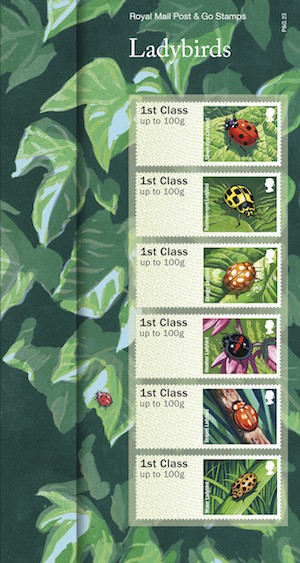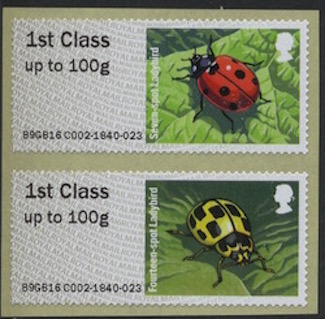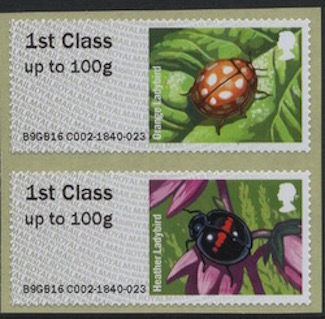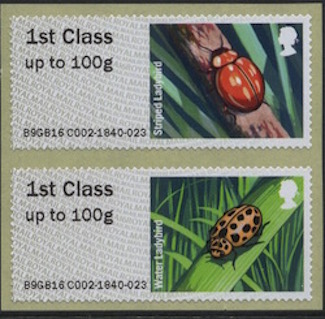Norvic Philatelics - GB New Stamps and Special Postmarks
Pictorial Faststamps: Ladybirds - 14 September 2016
Pictorial Post & Go stamps appear in
machines in UK Post Offices for defined periods of time in the year and
this series is intended to provide attractive stamps that are appropriate
for the season in which they are issued.
The second set for 2016 depicts "a celebration of British ladybirds and
their surprising variety of colours and forms". At the same time
Jersey Post will issue a set of six 'beetles' including the Orange,
Harlequin, and Seven-spot Ladybirds, and two beetles.
Post & Go terminals allow customers to weigh their letters and packets,
pay for and print postage stamps and stationery supplies, often without the
need to visit the counter. The first Post & Go machine was trialled in
The Galleries Post Office® in Bristol in 2008. The labels will be used
in Post & Go machines at Post Offices around the country, and from new
Royal Mail machines at Autumn Stampex. The labels at Stampex can be
obtained with 6 different service indicators: 1st class up to 100g & 1st
class Large up to 100g, a dual-value Europe up to 20g/World up to 10g,
Europe 100g, Worldwide 20g, and Worldwide 100g. The stamps are
dispensed singly or in strips of up to 6 of the same value or various
values.
Ladybirds are beetles of the Coccinellidae group. They spend the winter in a
dormant state and in early Spring emerge to forage. Of the 46 species that
live in the UK, the 2013 ladybird survey identified 26 as readily
recognisable as ladybirds.
Ecologically they are extremely important: many feed on destructive
creatures such as aphids (of which they can consume 5000 in a lifetime) and
hence are prized by gardeners as well as being economically important to
agriculture by eating pests of crops. Ladybirds are also important plant
pollinators. It is estimated that on recent decades populations have
declined due to habitat loss, use of chemical insecticides and climate
change (such as the exceptionally wet summers having an impact on the
ability of insects to fly).

The stamps in detail
Seven-spot Ladybird
One of the most common ladybird species across the UK, this iconic
bright-red beetle can be seen throughout the spring and summer searching for
aphids on nettles and other herbaceous plants. In the winter, it seeks
shelter under leaves and becomes dormant, to emerge in the spring ready to
mate.
Fourteen-spot Ladybird
With its characteristic square black spots on a yellow background,
this ladybird can often be found alongside Seven-spot Ladybirds feeding on
the aphids that infest a range of herbaceous plants. Its grub-like larval
stage has long legs and, like many other ladybird larvae, also feeds on
aphids.
Orange Ladybird
This ladybird has white splotches on an orange background and feeds
on the powdery white mildews that grow on the leaves of deciduous trees,
particularly ash and sycamore. It breeds later in the year than other
ladybirds, and its larvae take longer to develop than those of predatory
species.
Heather Ladybird
The delicate red markings on this small black ladybird appear as a
transverse line of red spots across the wing cases, but they are actually
two red spots broken into a dotted line. The Heather Ladybird is so named
because it is often found on heather heathland, where it feeds on scale
insects.
Striped Ladybird
Found on mature Scots pine trees, this ladybird is the most
specialised of all the aphid-eating ladybirds in the UK and is the second
largest ladybird in the country. Chestnut-brown, with pale cream stripes
rather than spots, it is very well camouflaged against the buds of Scots
pines.
Water Ladybird
This ladybird, which is more elongate than most species, undergoes a
dramatic transformation as an adult. In the winter, while tucked between
dead reed leaves, it employs buff-coloured camouflage, but in the spring,
when it goes off to search for aphids, it becomes brightly coloured, warning
potential predators that it tastes unpleasant.
Technical details:
Designed by Osborne Ross / Chris Wormell, the six 56mm x 25mm stamps are
printed in gravure by International Security Printers, with two phosphor
bars. The stamps in the pack will have the service indicator and other
detail printed in gravure.
All images are by kind permission of Royal Mail, Copyright 2016. This
website is copyright Norvic Philatelics 2016.
Products issued
The labels will be used in Post & Go machines at Post Offices around
the country, and from the Royal Mail machines at Autumn Stampex.
A mint set of 6 x 1st will also be available from Royal Mail's Tallents
House Bureau in a pack similar to a presentation pack (see right).
All values in the pack are 1st Class.
Royal Mail will again produce a First Day Cover and official First Day
Postmarks for these stamps.
Special Postmarks
Postmarks available for the day of issue
will be shown in Royal Mail's Postmark Bulletins (download
here).
This page created
16 August 2016
If you wish to be told when this page is updated, please use the
ChangeDetection box at the top of this page.
Instant
Printing Prices from Webmart






